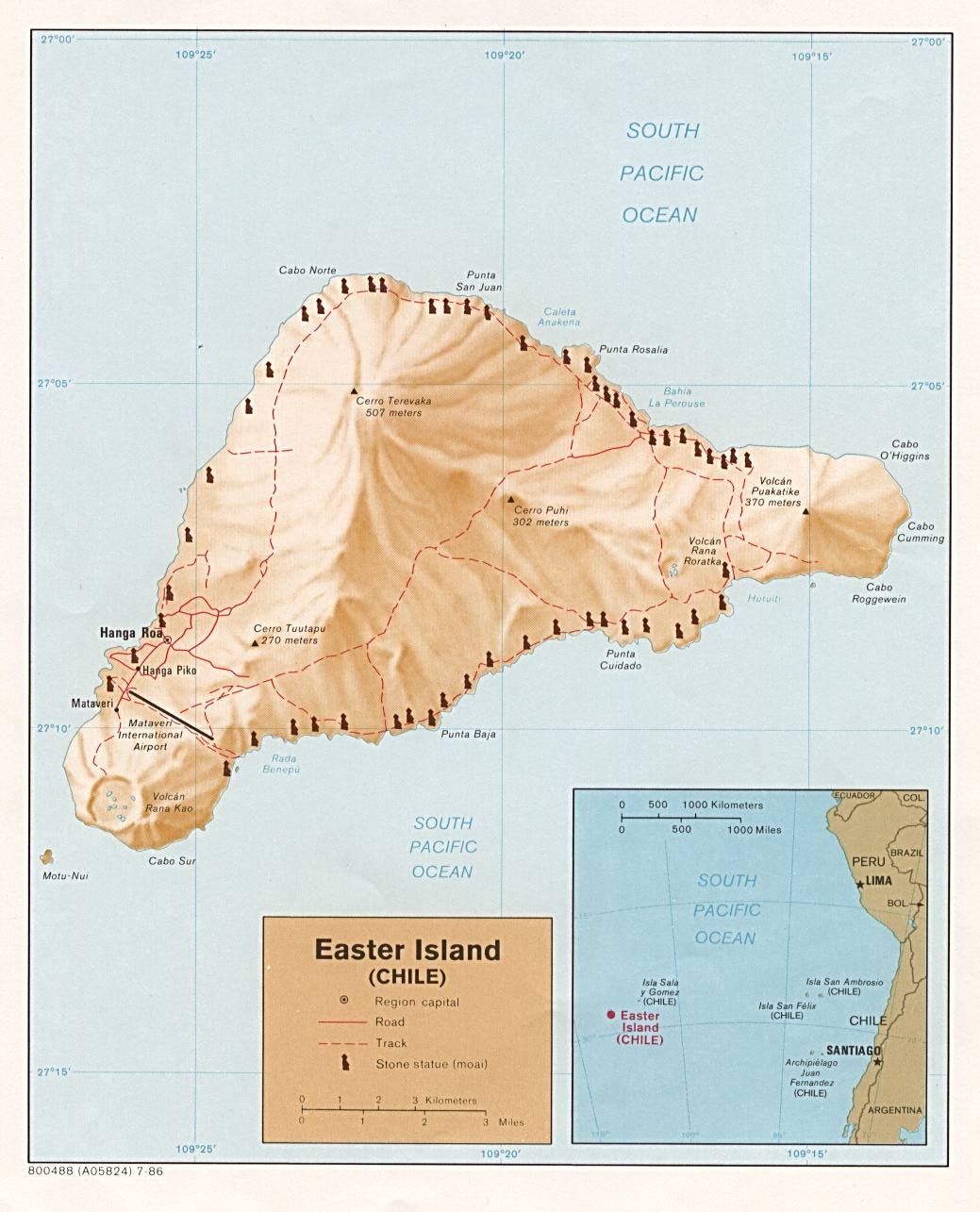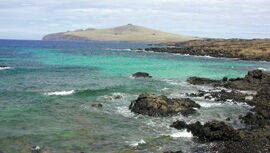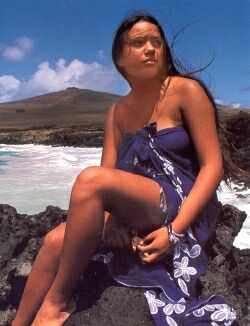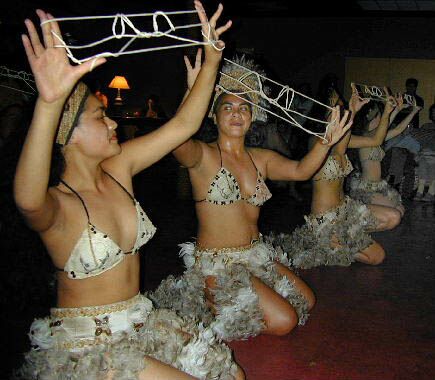
 Located 3600 km (2,237 statute miles) west of continental Chile and 2075 km (1290 statute miles) east of Pitcairn Island, it is the most isolated inhabited island in the world. It is located at 27°09'S 109°27'W, with a latitude close to that of the Chilean city of Copiapу, north of Santiago. The island is approximately triangular in shape, with an area of 163.6 kmІ (63 sq. miles), and a population of 3791 (2002 census), 3304 of which live in the capital of Hanga Roa. The island is famous for its numerous moai, the stone statues now located along the coastlines. Administratively, it is a province (containing a single municipality) of the Chilean Valparaнso Region. The standard time zone is six hours behind UTC/GMT (five hours behind including one hour of the daylight saving time).
Located 3600 km (2,237 statute miles) west of continental Chile and 2075 km (1290 statute miles) east of Pitcairn Island, it is the most isolated inhabited island in the world. It is located at 27°09'S 109°27'W, with a latitude close to that of the Chilean city of Copiapу, north of Santiago. The island is approximately triangular in shape, with an area of 163.6 kmІ (63 sq. miles), and a population of 3791 (2002 census), 3304 of which live in the capital of Hanga Roa. The island is famous for its numerous moai, the stone statues now located along the coastlines. Administratively, it is a province (containing a single municipality) of the Chilean Valparaнso Region. The standard time zone is six hours behind UTC/GMT (five hours behind including one hour of the daylight saving time).History
 Early Settlement and overview
Early Settlement and overviewEaster Island's human history began with the settlement of the island by Polynesians, who are likely to have arrived from the Marquesas islands from the west. The history of Easter Island can be related with the aid of a reconstructed king list of Easter Island, complete with events and approximate dates since the 5th century. These Polynesian settlers brought bananas, taro, sweet potato, sugarcane, and paper mulberry, as well as pigs, chickens, and rats. The island at one time supported a relatively advanced and complex civilization. European contact with the island began in 1722 on Easter Sunday when Dutch navigator Jakob Roggeveen found about 2,000-3,000 inhabitants on the island, although the population may have been as high as 10,000-15,000 only a century or two earlier. The civilization of Easter Island was long believed to have degenerated drastically during the 100 years before the arrival of the Dutch, as a result of overpopulation, deforestation and exploitation of an extremely isolated island with limited natural resources, some evidence to support that the island had a sudden collapse is the oral traditions of the islanders are obsessed with cannibalism, to severly insult an enemy one would say "The flesh of your mother sticks between my teeth", which would suggest that the food supply of the people ultimaly ran out; however, this extreme view was based on subjective interpretation of scientific evidence. All that can be said is that there was a massive, anthropogenic alteration of the ecosystem, and subsequently a cultural transition, but it was very likely not the catastrophic event long believed to be. By the mid-19th century the population had recovered to about 4,000 inhabitants. Then in a mere 20 years, deportation to Peru and Chile and diseases brought by Westerners almost exterminated the whole population, with only 110 inhabitants left on the island in 1877. It is more likely these events whose recollection by the descendents of the survivors have led to belief that they described ancient memories of a pre-contact collapse. Easter Island was annexed for Chile in 1888 by Policarpo Toro. The native Rapanui have since gradually recovered from this low point in their numbers.
Moai-carving culture (?5th century CE - ?14th/15th century CE)
Modern Easter Island has virtually no trees. The island once possessed a forest of palms and it has generally been thought that native Easter Islanders deforested the island in the process of erecting their statues. Experimental archaeology has clearly demonstrated that some statues certainly could have been placed on wooden frames and then pulled to their final destinations on ceremonial sites. Rapanui traditions metaphorically refer to spiritual power (mana) as the means by which the moai were "walked" from the quarry. Also important was the introduction of the Polynesian rat, which apparently ate the palm's seeds. However, given the island's southern latitude, the (as yet poorly documented) climatic effects of the Little Ice Age (about 1650 to 1850) may have contributed to deforestation and other changes. The disappearance of the island's trees seems to coincide with a decline of the Easter Island civilization around the 14th-15th century CE. Midden contents show a sudden drop in quantities of fish and bird bones as the islanders lost the means to construct fishing vessels and the birds lost their nesting sites. Soil erosion due to lack of trees is apparent in some places. Sediment samples document that up to half of the native plants had become extinct and that the vegetation of the island was drastically altered. Chickens and rats became leading items of diet and there are (not unequivocally accepted) hints at cannibalism occurring, based on human remains associated with cooking sites, especially in caves. Obsidian spear points and the toppling of many statues indicate a breakdown of the social structure, possibly even leading to civil strife, though almost certainly not on as massive a scale as is often assumed. There is no evidence of any South American contact with the island as was once suggested by Thor Heyerdahl, but some believe it possible that Polynesian sailors may have reached the central-south coast of Chile. Some "Polynesian-like" cultural traits, including words like toki, have been described among the Mapuche people from southern Chile.
The Birdman cult (?14th/15th century CE - 18th century CE)
The surviving population developed new traditions to allot the remaining resources. In the cult of the birdman (Rapanui: kangata manu), a competition was established in which every year a representative of each clan, chosen by the leaders, would dive into the sea and swim across to Motu Nui, a nearby islet, to search for the season's first egg laid by a manutara (sooty tern). The first swimmer to return with an egg would secure control over distribution of the island's resources for his clan for the year. The tradition was still in existence at the time of first contact by Europeans.
Whatever the reasons for this apparent decline, it was European intervention that delivered the final blow to Rapanui culture. In his article From Genocide to Ecocide: The Rape of Rapa Nui, Benny Peiser notes evidence of self-sufficiency on Easter Island when Europeans first arrived. Peiser's article is a scathing critique of Jared Diamond's book Collapse, accusing Diamond of pseudo-science. However, Peiser too does frequently ignore scientific fact that would contradict his theories (for example, he entirely glosses over the proven fact, borne out by archaeological evidence, that some sort of massive ecosystem degradation did come about as a consequence of Polynesian settlement, instead claiming it was not so, though this stands at complete odds with what is known about the ecological consequences of the Polynesian expansion - see also Henderson Island). His remarks about the post-contact decline of Easter Island culture are very valuable, however: Although stressed, the island may still have had at least some (small) trees remaining, mainly toromiro. Cornelis Bouman, Jakob Roggeveen's captain, stated in his log book, "...of yams, bananas and small coconut palms we saw little and no other trees or crops." According to Carl Friedrich Behrens, Roggeveen's officer, "The natives presented palm branches as peace offerings. Their houses were set up on wooden stakes, daubed over with luting and covered with palm leaves," indicating living palm trees were still available, though these were likely coconuts introduced after the extinction of the native palm.
Easter Island has suffered from heavy soil erosion during recent centuries, likely as a result of its deforestation. However, this process seems to have been gradual and may have been aggravated by extensive sheep farming throughout most of the 20th century. Jakob Roggeveen reported that Easter Island was exceptionally fertile, producing large quantities of bananas, potatoes and thick sugar-cane. In 1786 M. de La Pйrouse visited Easter Island and his gardener declared that "three day's work a year" would be enough to support the population.
Rollin, a major of the French expedition to Easter Island in 1786, wrote, "Instead of meeting with men exhausted by famine... I found, on the contrary, a considerable population, with more beauty and grace than I afterwards met in any other island; and a soil, which, with very little labour, furnished excellent provisions, and in an abundance more than sufficient for the consumption of the inhabitants." (Heyerdahl & Ferdon, 1961:57). A century later, Europeans apparently thought the island was suitable only for sheep farming.
Breakdown of native culture (18th - 20th century CE)
There are nearly 900 statues (moai) on the island, with about half remaining unfinished in the main quarry. The evidently abrupt halt to statue production hinted that some devastating event had ended the island's customary life and traditional culture. Although most of the statues seem to have been toppled by the islanders themselves after first contact with Europeans, there are indications that some carving of statues in the quarries may have continued until most of the population was taken captive and removed from the island by whalers and slave-raiders in the 19th century (Lavachery, 1935); however, sediment analyses point to a relatively abrupt cessation of large-scale moai crafting coincident with the extinction of the native palm and the beginning of the first social disruption. This catastrophe destroyed most of the island's oral traditions and knowledge of its culture and has greatly complicated any historical understanding of Easter Island. Oral history of a civil war of the ruling "long-ears" caste who were all but destroyed by the "short-ears", thought to relate to the upheaval connected with the end of the moai-carving culture and the emergence of the manutara cult, are more probably recollections of the destruction of the native culture by Europeans (the "short-ears").The first period of cultural breakdown and the emergence of the manutara cult seems to have been more of a gradual transition, stretching over several generations, and probably occurred without extreme episodes of violence, rather than the violent, rapid self-destruction it was long believed to have been. The narratives telling of such a violent, rapid transition are not very reliable, mixing recollection and myth indiscriminately, and being given by descendants of the few survivors of the enslavement drive by, chiefly, European whalers and later Peruvian and Chilean traders, thus probably relate to the latter.
Today
Until the 1960s, the surviving Rapanui descendants were forced to live in a confined settlement in squalid conditions at the outskirts of Hanga Roa. After they were finally allowed to live free, they have re-embraced their ancient culture, or what could be reconstructed of it. A yearly cultural festival, the Tapati celebrates native pastimes.
Rapa Nui is not the island's original name. It was coined by labour immigrants from Rapa in the Bass Islands, who likened it to their home island. The Rapanui name for Rapa Nui was Te pito o te henua (The Navel of the World) due to its isolation, but this too seems to have been derived from another location, possibly a Marquesan landmark.
Recent events have shown a tremendous increase of tourism on the island, coupled with a large inflow of people from mainland Chile which threatens to alter the Polynesian identity of the island. Land disputes have created political tensions since the 1980s, with part of the native Rapanui opposed to private property and in favor of traditional communal property (see Demography below).
Ecology
Easter Island, together with its closest neighbour, the tiny island of Sala-y-Gomez 400 km further East, is recognized by ecologists as a distinct ecoregion, called the Rapa Nui subtropical broadleaf forests. The original subtropical moist broadleaf forests are now gone, but paleobotanical studies of fossil pollen and tree molds left by lava flows indicate that the island was formerly forested, with a range of trees, shrubs, ferns, and grasses. A large palm, related to the Chilean wine palm (Jubaea chilensis) was one of the dominant trees, as was the toromiro tree (Sophora toromiro). The palm is now extinct, and the toromiro is extinct in the wild, and the island is presently covered almost entirely in grassland. Scientists at the Royal Botanic Gardens, Kew are reintroducing the toromiro to Easter Island. An interesting fact is the presence of the bulrush nga'atu which is also found in the Andes (where it is known as totora); there are indications that nga'atu was not present before the 1300s-1500s. Before the arrival of humans, Easter Island had vast seabird colonies, no longer found on the main island, and several species of landbirds, which have become extinct.
 Demography
DemographyPopulation at the 2002 census was 3,791 inhabitants, up from 1,936 inhabitants in 1982. This tremendous increase in population is due mainly to the arrival of people of European descent from the mainland of Chile. Consequently, the island is losing its native Polynesian identity. In 1982 around 70% of the population were Rapanui (the native Polynesian inhabitants). At the 2002 census however, Rapanui were only 60% of the population of Easter Island. Chileans of European descent were 39% of the population, and the remaining 1% were Native American from mainland Chile. 3,304 of the 3,791 inhabitants of the island live in the town of Hanga Roa.
Rapanui have also migrated out of the island. At the 2002 census there were 2,269 Rapanui living in Easter Island, while 2,378 Rapanui lived in the mainland of Chile (half of them in the metropolitan area of Santiago).
Population density on Easter Island is only 23 inhabitants per kmІ (60 inh. per sq. mile), much lower than in the 17th century heyday of the moai building when there were between 10,000 and 15,000 native Rapanui on the island. Population had already declined to only 2,000-3,000 inhabitants before the arrival of Europeans. In the 19th century, disease due to contacts with Europeans, as well as deportation of 2,000 Rapanui to work as slaves in Peru, and the forced departure of the remaining Rapanui to Chile, carried the population of Easter Island to the all time low of 111 inhabitants in 1877. Out of these 111 Rapanui, only 36 had descendants, and they are the ancestors of all the 2,269 Rapanui currently living on the island.
Cultural artifacts
The Moai
Moai in Hanga Roa, with Chilean Navy training ship Buque Escuela Esmeralda cruising behind. This moai is currently the only one with replica eyes
A MoaiThe large stone statues, or moai, for which Easter Island is world famous were carved during a relatively short and intense burst of creative and productive megalithic activity. Archeologists now estimate that ceremonial site construction and statue carving took place largely between about AD 1100 and 1600, with some statues probably still being carved at about the time Jacob Roggeveen discovered the island. According to recent archaeological research 887 monolithic stone statues, called moai, have been inventoried on the island and in museum collections. This number is not final, however. The on-going statue survey continues to turn up new fragments, and mapping in Rano Raraku quarry (see below) has documented more unfinished statues than previously known. In addition, some statues incorporated into ceremonial site construction surely remain to be uncovered. Although often identified as "heads", the statues actually are heads and complete torsos. Some upright moai, however, have become buried up to their necks by shifting soils. Most moai were carved out of a distinctive, compressed volcanic ash or tuff found at a single site called Rano Raraku. The quarry there seems to have been abandoned abruptly, with half-carved statues left in the rock. However, on closer examination the pattern of use and abandonment is more complex. The most widely-accepted theory is that the statues were carved by the ancestors of the modern Polynesian inhabitants (Rapanui) at a time when the island was largely planted with trees and resources were plentiful, supporting a population of 10,000-15,000 native Rapanui. The majority of the statues were still standing when Jacob Roggeveen arrived in 1722. Captain James Cook also saw many standing statues when he landed on the island in 1774. By the mid-19th century, all the statues had been toppled, presumably in internecine wars.
Rongorongo
Tablets found on the island and bearing a mysterious script known as Rongorongo have never been deciphered despite the work of generations of linguists. In 1932 Hungarian scholar Wilhelm or Guillaume de Hevesy called attention to apparent similarities between some of the rongorongo characters of Easter Island and the prehistoric script of the Indus Valley in India, correlating dozens (at least 40) of the former with corresponding signs on seals from Mohenjo-daro. This correlation was re-published in later books, for example by Z.A. Simon (1984: 95), but later works showed these comparisons to be spurious.
Some writers have asserted rongorongo means peace-peace and that their texts record peace treaty documents, possibly between the long ears and the conquering short ears. However, such explanations have been strongly disputed, particularly since the "long-ear/short ear" designations of historical islanders have become increasingly unsupportable.
Like most indigenous tellers of Easter Island histories or legends, islanders continue to have questionable motives for their accounts and have always been creative, imaginative and quick to give answers to inquisitive archaeologists and historians. Rongorongo's purpose and intent remain as puzzling as the script's meaning. While there have been many claims of translation, none have withstood peer review. S.R. Fischer has reportedly made the most extensive study of Rongorongo to date and in his book Glyphbreaker he claims to be the first to successfully decypher it. However, to date no one has been proven to have successfully deciphered this text.

